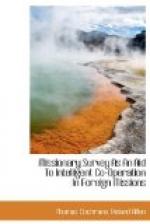We therefore include a table identical for medical and educational workers:—
-------------------------------------------------------
-------------- | Total | Total | Total Native | Volunteers | Expense | Foreign | Contribution | for | of Work in | Contribution. | Fees and | Training. | Station | | Donations. | | Area. | | | ------------------------------------------------------------
--------- Medical | —— | —— | —— | —— ------------|------------|---------------|--------------|---
--------- Educational | —— | —— | —— | —— ------------------------------------------------------------
---------
CHAPTER VII.
CO-OPERATION BETWEEN THE DIFFERENT ELEMENTS IN THE MISSION.
We have now surveyed the evangelistic, medical, and educational work in the station district, viewed separately. It remains to unify the results, that we may get, if possible, a definite conception of the whole. The effectiveness of the mission machinery largely depends upon the relation of these parts to one another. The mission ought not to be three separate things but one thing; for the impression produced upon the non-Christian population is the result of the combination of all the various forms in which the one missionary spirit expresses itself. The spirit which produces them all is one, and it is that one spirit which influences and converts the heathen.
Now we already know the proportion in which workers and funds are divided between the three branches (p. 68). We already know something of the work done by evangelists in hospitals (p. 83), and by doctors in evangelistic tours (p. 84); and of the extent to which the work in the hospitals opens up the way for evangelists (p. 85). We already know something of the work done by evangelists in schools (p. 99), and of the evangelistic influence of the educational work (p. 102, 103), and of the extent to which educationalists assist in evangelistic tours (p. 101).
If then we now add tables to show the help given by the medicals in the schools and the work done by the educationalists in the hospitals we shall be able to gain a fairly complete idea of the co-operation between the three branches.
But it is just at this point, the relation between the medical and educational work, that we shall probably find most difficulty. This relationship has not been carefully thought out in the past, and co-operation between medicals and educationalists is, we fancy, somewhat rare. Few men could tell us exactly what policy is followed, or ought to be followed. This is partly due to that confusion of purpose of which we spoke in the first chapter, a confusion which obscures and confounds our medical and educational missions. If both medical and educational missions had had one common dominant purpose, the relation between




